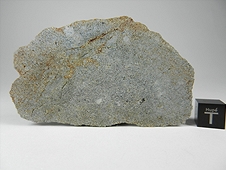NWA 2828 Enstatite (EL3-6) Meteorite

NWA 2828 is an unusual EL3 Chondrite "Fossil Meteorite" occurring as cobbles in a terrestrial conglomerate. We first called this as a "Paleo-Meteorite" but a consensus in the scientific community prefers the term "Fossil Meteorite." This enstatite-rich meteorite was first discovered in Algeria and/or Western Sahara in 2005. It was originally thought to be an aubrite, but scientific examination of new material has revealed the presence of features that require revision of that classification. Several stones contain sparse (<1 vol.%) but very distinct round, radial pyroxene chondrules up to 3 mm across, as well as rounded, fine-grained aggregates up to 6 mm across composed mainly of either enstatite or sodic plagioclase (image 3). The dominant primary phase in NWA 2828 is essentially pure enstatite, which forms stubby prismatic grains.
New information on the find site in Western Sahara indicates that the NWA 2828 material was excavated from a subsurface deposit, and terrestrial rhyolite pebbles and sandy matrix are attached to several NWA 2828 stones. The pebbles cling to them via iron oxide/carbonate cement. The oxides are finely layered and alternate between magnetite and hematite, with inter layers of saline deposits. This suggests times of past wet to dry periods in a river or salt lake. However, the iron oxides contain nickel in a range of up to 6.5 percent, which strongly suggests that the pervasive 0.5 - 2 mm cavities in the NWA 2828 stones are the result of solution etching. The scientists who conducted the studies have concluded that incoming solutions replaced the primary nickel-iron grains with salts, carbonates, etc., while outgoing solutions formed nickel-rich iron oxides on the exterior of the stones, and cemented all of the neighboring terrestrial debris to the meteorite stones.
All this evidence for acidic alteration and precipitation in cavities combined with the terrestrial rhyolite pebbles cemented by sand seems to indicate that the NWA 2828 stones are partially altered EL3 chondrite fossil-meteorite cobbles in an ancient fluvial conglomerate. In such a river environment with intermittent high water volumes it is quite possible over time for original metal grains to be completely dissolved out of cobble-sized EL3 chondrite fragments. EL3 chondrites are extremely rare meteorites - other than this new specimen, only three Antarctic and one, (or possibly two), African examples are known, making EL3 chondrites rarer than aubrites!
Northern Arizona University classification discussion of NWA 2828/Al Haagounia:
Click here for Northern Arizona University (NAU) web site classification discussion
Meteoritical Bulletin entry for NWA 2828 (incorrect), should read "EL3":
Click here for the Official (incorrect) classification of NWA 2828
New information on the find site in Western Sahara indicates that the NWA 2828 material was excavated from a subsurface deposit, and terrestrial rhyolite pebbles and sandy matrix are attached to several NWA 2828 stones. The pebbles cling to them via iron oxide/carbonate cement. The oxides are finely layered and alternate between magnetite and hematite, with inter layers of saline deposits. This suggests times of past wet to dry periods in a river or salt lake. However, the iron oxides contain nickel in a range of up to 6.5 percent, which strongly suggests that the pervasive 0.5 - 2 mm cavities in the NWA 2828 stones are the result of solution etching. The scientists who conducted the studies have concluded that incoming solutions replaced the primary nickel-iron grains with salts, carbonates, etc., while outgoing solutions formed nickel-rich iron oxides on the exterior of the stones, and cemented all of the neighboring terrestrial debris to the meteorite stones.
All this evidence for acidic alteration and precipitation in cavities combined with the terrestrial rhyolite pebbles cemented by sand seems to indicate that the NWA 2828 stones are partially altered EL3 chondrite fossil-meteorite cobbles in an ancient fluvial conglomerate. In such a river environment with intermittent high water volumes it is quite possible over time for original metal grains to be completely dissolved out of cobble-sized EL3 chondrite fragments. EL3 chondrites are extremely rare meteorites - other than this new specimen, only three Antarctic and one, (or possibly two), African examples are known, making EL3 chondrites rarer than aubrites!
Northern Arizona University classification discussion of NWA 2828/Al Haagounia:
Click here for Northern Arizona University (NAU) web site classification discussion
Meteoritical Bulletin entry for NWA 2828 (incorrect), should read "EL3":
Click here for the Official (incorrect) classification of NWA 2828
Copyright 2012 - Current All Rights Reserved Nature's Vault, Inc.





